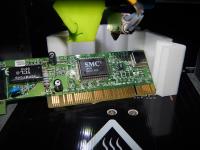How to print a loudspeaker? The answer is: printed structural electronics
Heterophasic functional materials for structural electronics. Sounds confusing, doesn't it? Well, no. Quite the contrary. Marcin Słoma PhD (Eng.) from the Faculty of Mechatronics, has been developing materials which, contrary to what may seem, could make our daily lives easier.
The researcher of The Warsaw University of Technology has received a grant of PLN 1.98 million for his research from the Foundation for Polish Science. The grant was provided as part of the FIRST TEAM programme that helps young scientists to conduct research that may be a breakthrough in science or business. What breakthrough is Dr Słoma working on for us? "It's about composite materials that we could use to print three-dimensional electronic circuits,” he explains.
Printed 3D electronics
Dr Słoma would like to replace the traditional methods of making electronic circuits with 3D printing technology so that one day people could print a phone or a tablet. Of course, this technology has its own limitations. For example, printing high-performance integrated circuits (or chips) is not possible yet and, in fact, is not necessary. "Tracks, resistors, antennas, switches, or perhaps even lighting elements, could be easily printed," Dr Marcin Słoma enumerates. "The idea is to be able to use a single process and a single device to print both an electronic circuit and its packaging or case".
The research project aims to develop materials that we could use to print conductive tracks, resistors or sensors. "If the research goes the way I would like it to go, it is my ambition to print such things as a motor or loudspeaker and, eventually, almost an entire electronic circuit," Dr Słoma anticipates.
It's easier, cheaper and better
Structural electronics include electronic elements and circuits built into structures, cases or others structural parts (such as vehicle bodies, bridges). These parts and circuits can be integrated into the structure or placed on its surface. Its sister technology of printed electronics already allows for mass production of items with structures of low or medium complexity. This technology delivers printed elements that are more practical and cheaper to make, and which can easily be re-designed to meet the individual requirements of customers. It is no surprise that researchers in all parts of the world are interested in structural electronics; scientists at Harvard University, The California Institute of Technology and Berkeley University are already working on projects in this area.
Printed 3D structural electronics can be used in many areas, including the automotive sector, military and medicine, as well as civil engineering and construction. Aircraft manufacturers, too, are interested in this technology, developing it to replace wires with tracks in the outer skin of the fuselage, which could help slim down aircraft by even a few tonnes. This technology not only saves you time and money, but it is environment-friendly as well.
"You will only use as much material as you need for production," Dr Marcin Słoma talks about the benefits of 3D printing. "You also produce less waste and your workers are less exposed to toxic substances".
Do it yourself?
Simple 3D printers for home use are already available. Is it possible that in the future, anyone will be able to use the materials developed by the researchers of the Faculty of Mechatronics, Warsaw University of Technology (WUT), to print a phone, for example? Not really, because the materials that Dr Słoma is working on will need more advanced printers, and specialist materials can be cheap only if they are mass-produced, but not for the average user.
While you are not likely to be able to print electronics at home, the materials that the WUT researchers are working on could, when slightly modified, be used with the existing production printers. However, this technology will be reserved for industry only.
From science to business
The team led by Dr Marcin Słoma will be working on various materials, including conductive materials, resistors, lighting elements and magnetic elements. The researcher expects the materials to be suitable for use with various structural electronics printing methods, such as FDM, SLS, ink-jet printing or selective spraying.
All the materials will need to be tested for their electrical or mechanical properties. The research project will also involve businesses that will provide suggestions about what solutions are needed and what materials would be useful. Dr Słoma notes that industrial manufacturers are not prepared to use the solutions proposed by scientists. "We, researchers, are the kind of people who are doing something today, but will no longer be interested in it after five years," he explains. "Then we will start working on something else and will not be happy to look back". Science is moving on, progressing, and if manufacturers do not look at the results of our work early enough, our solutions will be shelved again.
The manager of the project also expects to apply for patent protection for the materials and technologies developed in the project. Dr Słoma himself already has a few patents, so his team should be successful this time as well. Will the Warsaw University of Technology be able to make its contribution to the development of structural electronics? We need to wait three or four years to see. This is the time needed to complete the research.
Monika Bukowska
Office for Promotion and Information








